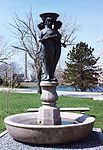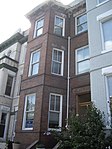Glenwood Cemetery (Washington, D.C.)
1854 establishments in Washington, D.C.Art Nouveau architecture in Washington, D.C.Art Nouveau cemeteriesBurials at Glenwood Cemetery (Washington, D.C.)Cemeteries in Washington, D.C. ... and 1 more
Cemeteries on the National Register of Historic Places in Washington, D.C.

Glenwood Cemetery is a historic cemetery located at 2219 Lincoln Road NE in Washington, D.C. It is a private, secular cemetery owned and operated by The Glenwood Cemetery, Inc. Many famous people are buried in Glenwood Cemetery, and the cemetery is noted for its numerous elaborate Victorian and Art Nouveau funerary monuments. The cemetery was listed on the National Register of Historic Places in 2017; its mortuary chapel was separately listed in 1989.
Excerpt from the Wikipedia article Glenwood Cemetery (Washington, D.C.) (License: CC BY-SA 3.0, Authors, Images).Glenwood Cemetery (Washington, D.C.)
Bryant Street Northeast, Washington
Geographical coordinates (GPS) Address Nearby Places Show on map
Geographical coordinates (GPS)
| Latitude | Longitude |
|---|---|
| N 38.9229 ° | E -77.006 ° |
Address
Glenwood Cemetery Mortuary Chapel
Bryant Street Northeast
20002 Washington
District of Columbia, United States
Open on Google Maps










